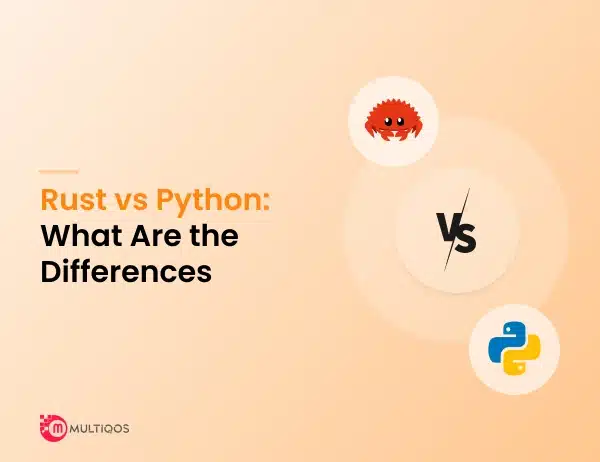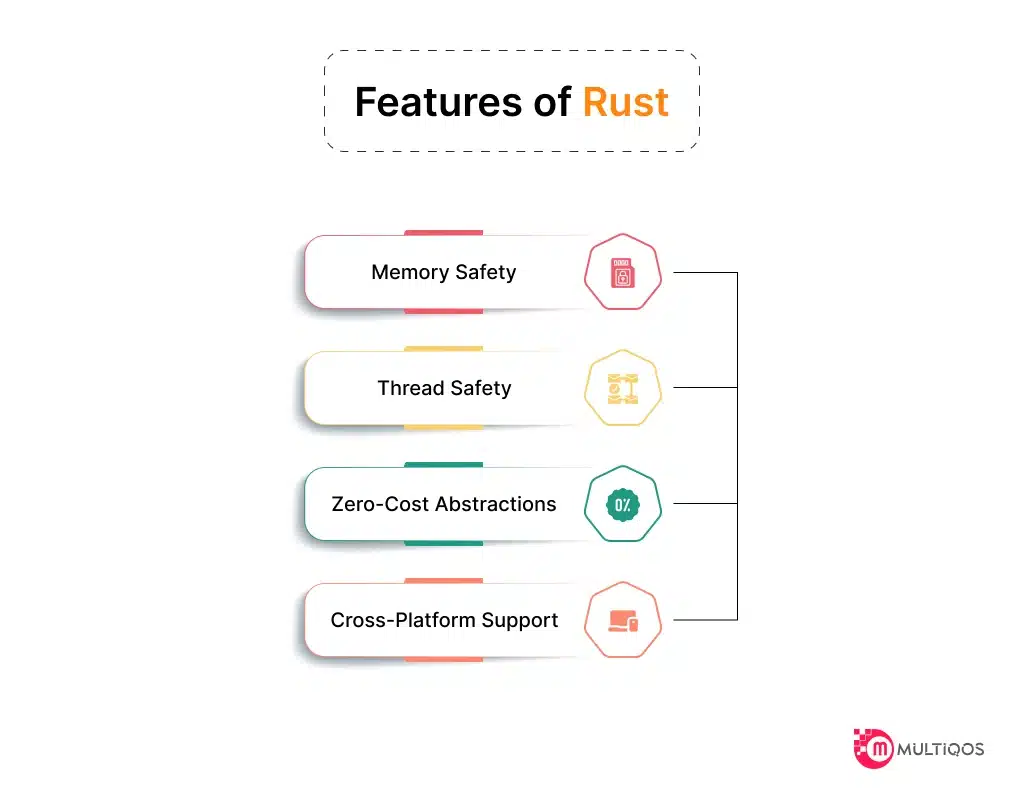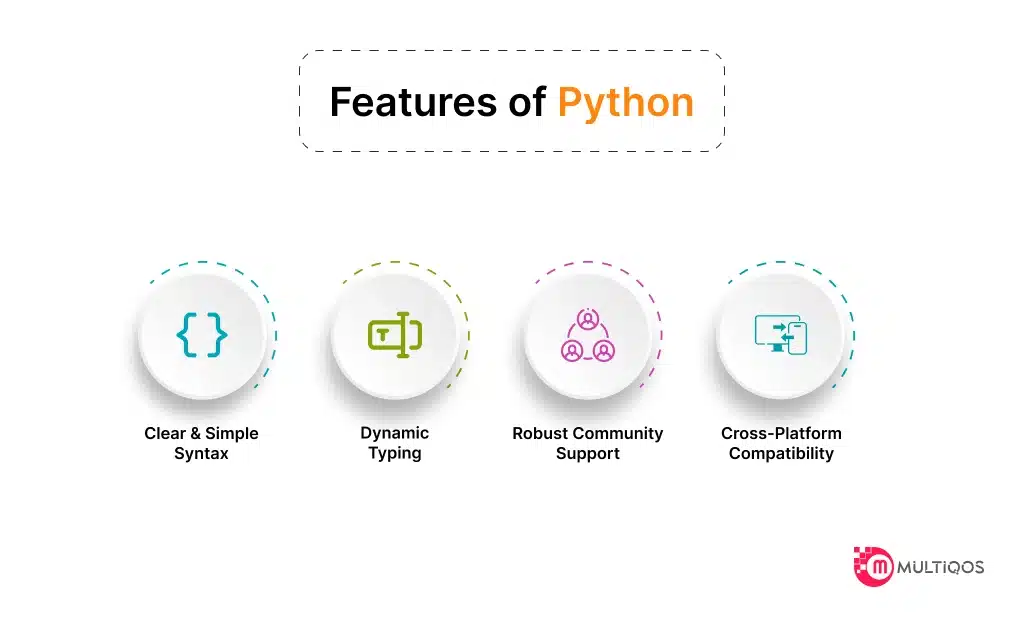
Table of Contents:
- Introduction
- Rust: Overview and Benefits
- How Rust Can Help Your Business
- Rust: Common Challenges
- Key Features of Rust
- Python: Overview and Benefits
- Why Developers Prefer Python
- Drawbacks of Python
- Key Features of Python
- Popular Python Use-Cases
- Rust vs. Python: A Comparison
- Rust or Python: Best for Your Project?
- Conclusion
- FAQs
Choosing between Rust and Python is not a very easy decision for the app developers who are searching for the right language for the given project. As for the key aspects, we are talking about Python which is another powerful language with more peculiarities and active community support.
It is sometimes challenging to definitively state which language is better suited to which task, as both Rust and Python are powerful languages with many unique features, so this article compiles relevant information about the languages’ attributes for your convenience.
Rust and Python will be compared on many parameters such as memory management, cross-platform compatibility, and concurrency. At the end of this blog, you will be equipped with knowledge of how the two languages function in those areas to enable you to make a prudent decision when choosing one for your new project.
Let’s discuss the strengths and the differences between Rust and Python so you can establish what language will be best for your software development venture.
Rust: Origin, Popularity, and Uses
Rust is a new generation multiparadigm programming language developed by Graydon Hoare while working in Mozilla Research. Although it is relatively new, it is celebrated for safety, stability, and performance; it is intended to construct memory efficient architectures in line with C/C++.
Compared with Python, Rust is relatively new; however, it has already earned significant popularity among the programmers. As per the recent survey of TIOBE Index July 2024, it has been witnessed that things are looking brighter for Rust as the programming language would soon be positioned in the TOP 10.
Another common use that is relevant to this topic is related to system development, web applications, even in embedded systems, blockchain, and gaming engines. Surprisingly, 84+ percent of developers who stick to Rust crave it as their primary language and intend to keep exploring it.
How Can Your Business Benefit from Rust?
Here are the three major advantages that the Rust programming language brings to your organization.
Performance-Oriented Design
Rust is positioned to be a high performance that provides increased execution speed and low memory consumption. It does not consume additional time in the runtime and works well without having to be garbage collected–it is virtually extremely fast.
Rigorous Memory Safety
Rust makes manageable memory because it provides rules that act like a safety guard that improves the stability and security of the software applications.
Low-Level Resource Control
As for the runtime, Rust grants direct and safe control of the low-level system resources as C/C++ does but with more safety guarantees and an appropriate set of primitives for managing them.
Four Pitfalls You May Face While Using Rust
Just as Python, Rust also has its share of pitfalls. Check out the disadvantages of Rust.
Slower Compilation Times
Rust’s compiling mechanism can take comparatively more time than other languages as Rust compiles the complete packages or crates at a time.
Steep Learning Curve
Rust programming language may be difficult to learn especially for novices of programming. There is general advice to already know at least one other programming language to understand Rust’s concepts.
Limited Monkey Patching Support
Rust has limited monkey patching, which is a feature that allows the alteration/modification of the program through dynamic code execution. This can turn out to be rigid, especially in some programming paradigms.
Larger Binary Files
As the focus of Rust is performance and safety, the language can generate binaries of greater size compared to languages that offer smaller executable sizes as a priority.
What Are the Features That Rust Offers?
Rust supplements C++ features and has features such as memory safeguarding, thread safeguarding cross-platform compatibility, and completely free abstractions.
Memory Safety
Rust does away with most memory problems and pitfalls through the use of its ownership model accompanied by a sound type system, thus allowing errors to be observed and reported at compile time and not at runtime hence doing away with the garbage collector.
Thread Safety
Ownership of data is another means through which Rust enhances the safety of the threads. It asserts that at a given time, only one thread can write onto a variable; this eliminates the instance of a race condition as well as guarantees safe concurrent execution of a piece of code.
Zero-Cost Abstractions
Seller calls offer strong abstractions that don’t cost the program a heavy runtime penalty. This helps the developers to develop good algorithms, generate efficient code, and all this without compromising on either the readability of the code or the complexity of the algorithms.
Cross-Platform Support
Rust can be developed for the Windows, Linux, and macOS platforms that are officially supported. Another of Its Cargo build tools is meant to help in the easy deployment of codes into different environments without much manual configuration.
Python: Origin, Popularity, and Uses
Python is a popular scripting language of the present era that favors both an Object-oriented approach and a functional approach. Created by Guido van Rossum in 1991, Python is famous for being easy to learn and use and for being suitable for many different applications. It has a function of rapid mobile application development due to the features of dynamic typing and binding.
Python is applied in almost every field like data science, web development, automation, testing, and prototyping with nearly 183339 companies using as per the report by 6sense (2024).
A non-convoluted syntax of the language also makes the maintenance of code a simple exercise, no matter how complex the progression may be to upcoming programmers or even the most seasoned IT personnel.
The simplicity of the language is accompanied by the inclusion of both an extensive standard library of the language and a lot of third-party packages that help in functions ranging from data analysis to building machine learning models.
Python coding language’s social support, availability of materials, and product documentation are solid hence making it dependable for all forms of developers.
Python Advantages: Why 49.28% of Global Developers Love Python?
Python has reserved its place amongst the most widely used programming languages as per Statisa survey with almost half of the developers population around the globe adoring it. Find out the core advantages that it offers.
Ease and Efficient Use
On the one hand, the syntactic structure of Python is iconic, therefore it is simplistic and comprehensible, but on the other hand, it is flexible and comprehensive to solve complicated problems. Enumerated asynchronously it offers effective coding that is effective in organizing and performing tasks.
Extensive Libraries and Frameworks
It has a vast number of libraries and frameworks to choose from due to the language’s popularity and a healthy open-source culture. This way, developers are provided with tools for as many uses as possible.
Seamless Integration
Python is particularly good at interacting with other systems such as enterprise applications and databases. It is integration with other languages for example PHP and dot. Due to NET’s ability to derive and adapt various functionalities, it improves its flexibility and functionality.
Future-Proof Development
Python’s reputations in AI & Machine learning have made it an irreplaceable language in modern technological development. Its adaptability confirms that the application developed in Python can cope with future market requirements; all applications require easy updates and durability.
The Downfalls of Python as a Programming Language
Python being a general purpose programming language has many merits, however, it does have certain pitfalls of its own, take a look.
Performance Issues
Interpreting distinguishes Python for worst relative to such compiled languages as C++ or Java and this is due to the reason that Python is slow in its execution especially in CPU-intensive computations.
Concurrency Constraints
The downside of using python is that it is known from its Global Interpreter Lock (GIL) that blocks simultaneous execution of threads and is less ideal for applications that are built on multiple threads.
Dynamic Typing Challenges
However, the dynamic typing in Python makes it somewhat flexible and results in run time errors that are detected at the runtime as opposed to being detected at compile time to consequently affect the stability of the program.
The Core Features of Python You Must Know
Python’s popularity is pinned by an array of features that it offers to your web development project. Check them out here.
Clear and Simple Syntax
Python has a simple language structure that is easy to learn by developers and results in the writing of fewer lines of code which enables developers to meet deadlines faster hence reducing the time to market.
Dynamic Typing
As for Python language, it is also important to note that variable types do not have to be declared. It provides types at the runtime depending on the assigned value by getting rid of the need to devote much time and effort to types as enjoyed by language developers.
Robust Community Support
Packed with a large supporting community and several subgroups around the world that are zealously involved in updating the software. This community offers fast fixes for problems and has abundant assets, such as papers, guides, videos, and tutorials.
Cross-Platform Compatibility
Different platforms can support the Python applications, for instance, Windows, Linux, and MAC all this makes it easier for Pyramid to deploy and maintain the different events in different platforms.
Eight Popular Use-Cases of Python
Explore how you can employ Python across different applications for your organization.
Web Development
Web development is another of the many areas where Python finds application, due to the availability of web development frameworks such as Django and Flask.
Desktop GUI Applications
GUI frameworks in Python including Tkinter, PyQt, and Kivy enable the development of desktop applications in Python.
Scientific Computing
Python is commonly used in scientific computing with possibilities of NumPy for calculations and SciPy and Matplotlib for data analysis and visualization.
Automation and Scripting
Python is easy to write, and the scripts written in Python semantically are easy to read, so it is effectively used in writing scripts for repetitive tasks to enable faster performance.
Data Science and Analytics
Now, Python is widely used in data science and analytics due to such strong libraries as Pandas, sci-kit-learn, and TensorFlow for data processing, analysis, and machine learning.
Healthcare
Currently, there is a growing use of Python in such areas as healthcare, particularly in applications that enable the management of a patient’s records, and interpretation of images used in various diagnostic processes, among others.
Networking
Python helps in creating network applications and protocols more easily and allows the use of libraries Twisted and Python Async.
Game Development
Python is also applied in game development whereby it offers Pygame, which is a set of libraries that ease game and other interactive application development.
Rust Vs Python: A Detailed Comparison
By now we have known individually about both the programming languages namely Rust and Python. Let’s also compare both of them head-on to get better clarity on which one’s better.
-
Ease of Use and Learning
Python is admired for its simplicity and vast availability of libraries in the market; this language is suitable for beginners. Due to its simple syntax and because of its utility in various fields, beginners find it easier to use Python as their first programming language.
Despite this, Rust has a steeper learning curve due to the more extensive and detailed grammatical rules and instruments than Golang. However, Rust provides a fairly extensive set of tools, which is why Python and its simplicity, as well as low requirements in terms of code, are more often chosen by beginners.
-
Performance
Rust is designed to offer outstanding performance, faster than the languages that depend on an interpreter, and has more efficient memory management. What makes Rust the best for performance use is the fact that a Rust program will run at a higher speed.
Python on the other hand is slower due to two reasons: interpreted language and runtime garbage collection. Depending on the application a system is used for this could be a disadvantage as it limits the performance.
-
Garbage Collection
Rust does not have garbage collection at the runtime level; this reduces costs associated with checking for memory management during the program’s operation. This contributes to its high performance. This analysis of the research shows that taxes on luxury goods have a positive impact on their sales since they favor high-end brands.
The memory management in Python is done at runtime through garbage collection, therefore resulting in a negative influence on the performance as there are always delays while the garbage collector is sweeping through memory.
-
Memory Management
The memory management in Python is done using garbage collection where Python sometimes scans for or frees the memory space that is not in use.
Rust’s memory model is based on the ownership model and rejects all the forbidden operations at compile-time. This approach differentiates between stack and heap memory where the stack memory is used for scalars and heap memory is used for non-scalars and is much more efficient than the garbage collection of Python.
-
Error Handling
Python employs runtime exceptions as the mechanism of error handling and they are identified as the program is being run with little to guide one in their solution.
Rust, on the other hand, does runtime checking and offers a solution of how the programmer can fix the error. This goes a long way in the early identification and safeguarding of problems that would otherwise affect the reliability of the code embedded in software.
-
Security
Secure Rust Guidelines are used by Rust for achieving memory safety and become a way of showing memory issues at compile-time. Also, there are frequent updates from the Rust team in the fight against security vulnerabilities.
Thus, although Python is as secure as Java, it lacks the memory and thread safety features that the latter possesses. Memory must be handled by developers in a more raw way so potential memory leaks have to be controlled by the developer, possibly adding additional layers of security.
-
Community
Furthermore, both RustPython and PythonRust belong to the open-source population and thus embrace the ability of the society’s contributions and additions. Python has been around for a long time and is used a lot which has given the language a strong base of support from which a lot of information and materials can easily be found.
Rust, while having fewer players, is commercially growing fast and has a very active and friendly community. Rust’s community is smaller and thus it provides a more detailed set of sources; Rust is progressively developing.
-
Scalability
While Python is resourceful because it is a high-level language it has significant performance and memory management issues when it comes to scaling large applications. Nevertheless, problems like these can be reduced with the help of horizontal and vertical scaling techniques that make Python capable of handling heavy loads.
Scalability is a characteristic that appears to be inherent in Rust due to the company’s high-performance structure, ensuring that constructing more efficient web services can occur with reduced infrastructure requirements and, therefore, reduced costs.
-
Extensibility
Python is very extensible due to a large number of libraries, modules, and frameworks that can be used to cover almost anything that can be imagined, ranging from simple automation scripts to serious web applications.
Statistically, Rust’s ecosystem is expanding, characterized by the constant increase of available crates in Rust’s community registry. As Rust is extending its scope, at the moment it does not equal the number of Python language libraries.
Rust Vs Python: What’s the Best Option for Your Project?
Both Rust and Python have their own share of advantages and disadvantages as discussed till now. But to decide the best one for your project, you need to know when to choose what. Here are the points for the same.
Choose Rust as Your Programming Language When You Want –
High-Performance
Use Rust when speed and performance are the main priorities of your application. It has a performance-oriented design that guarantees an agile operation in terms of memory.
Memory Safety
Rust is suitable for use in scenarios where it is necessary to have memory safety and where many problems can be caught at compile-time. The ownership model plays a vital role in reducing bugs before the program is run.
Systems Programming
Choose Rust whenever you are going to perform system-level operations, implement low-level hardware interactions, or create your own OS, if you need precise control over resources.
Concurrency and Parallelism
Rust is good for applications that need careful handling of concurrent tasks and safe and ‘parallel’ operations because Rust does an exquisite portrayal in handling multithreading.
Choose Python as Your Programming Language When You Want –
Rapid Prototyping and Development
Choose Python as a language when you work on the development of applications and need to prototype this development. Due to its easy syntax and large amounts of available libraries, development and prototyping can be done quickly.
Strong Library and Framework Facility
Select Python if you need to use extra libraries and frameworks as the product’s diversity ranges from web development to data processing.
Data Analysis and Machine Learning
Python is used to the best for data analysis, machine learning, and scripting languages. These tasks are done conveniently by its powerful libraries like Pandas, NumPy and TensorFlow.
Versatility and Community Support
Choose Python if you are looking for versatility and a prominent community backup. If your project’s application is not limited to a certain field, thus resources are easily found and people are active which guarantees help.
The Final Lines
Python continues to be the most popular programming language in all areas because of the simplicity, dynamic typing, libraries, and community support. While being rather simple to understand and highly flexible it occupies a very important position in the job market.
Rust is comparatively newer but it is already quite popular because of the additional abilities it has over other languages such as memory safety, thread safety, zero-cost abstractions, and high performance. Among the tech corporations, Python is already widely used, while Rust is equally actively used by such industry giants as Amazon, Facebook, and Microsoft.
Thus, despite the disadvantages of Rust, which concern slower compile times and low compatibility with the monkey patching tradition, the language offers such important benefits as improved error handling, absence of the garbage collector as a problem to solve, effective memory management, and high performance. While Python is slower in execution and has limited DB connectivity and mobile application development support.
The essence of job opportunities, the simplicity of usage, the availability of community support- all of these are present in Python. However, given how well Rust performs and how safe it is, the reasons for its increased usage, and Rust becoming the most used language in the near future makes sense.
FAQ on Rust vs Python in 2024
Yes, cross-compilation is possible in Rust. If cross-compilation has to be handled in Rust, it also means that libraries must then also be cross-compiled to keep in step. Currently, there is no way of doing it automatically; to access other directories, developers have to go there manually. The standard library copies could be obtained from rust-std-* files, located on the distribution page.
Yes, Rust has various libraries through which users can incorporate Python code into the language. Of the languages, PyO3 is commonly used for this purpose. It is possible to get the wanted accessibility and functionality of Python inside the Rust code if you install proper extensions.
The good thing is that Rust is a compiled language so it performs better like C and C++. Speaking of efficiency, Python is less efficient as it is an interpreted language that is, compared to compiled languages, it usually runs slower but on the other hand, it can be easily used and fast to develop, therefore, suitable for many applications where they don’t need to be very fast.
Their program uses ownership to deal with memory which is a system that can handle memory safely without having to involve a garbage collector. Python also uses automatic garbage collection of objects that are no longer needed in the application, which makes memory management easy for the programmer; however, it is not very efficient because its overhead is unknown.
Altogether, it could be said that Python is considered to be more accessible due to simplified and comprehensible code, which is beneficial for novices and for fast prototyping. Compared to Rust, one is going to learn a lot of things about system-level programming and Rust compiler rules are a lot more strict but Rust has more profound features in terms of safety and computing efficiency.
Rust is mainly useful for performance-sensitive usage, systems programming, and programming environments that require high safety and concurrency such as games and real-time systems. Python is general-purpose, and popular in web development, data and science, AI/machine learning, automation, and prototyping.
Get In Touch








